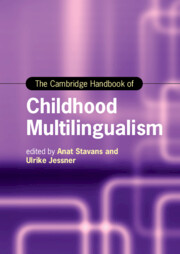Book contents
- The Cambridge Handbook of Childhood Multilingualism
- Cambridge Handbooks in Language and Linguistics
- The Cambridge Handbook of Childhood Multilingualism
- Copyright page
- Contents
- Figures
- Tables
- About the Editors
- Contributors
- Acknowledgments
- Multilingualism Is Not Bilingualism +1: An Introduction
- Part One Becoming and Being a Multilingual Child
- Part Two Cognition and Faculties in Multilinguals
- Part Three Family Language Policy
- Part Four Language(s) and Literacy of Multilingual Children through Schooling
- Part Five Socialization in Childhood Multilingualism
- 21 Building a Plurilingual Identity
- 22 Multilingual Parenting in the United States: Language, Culture and Emotion
- 23 The Development of the Heritage Language in Childhood Bi-/Multilingualism
- 24 Social Cohesion and Childhood Multilingualism in South Africa
- 25 Growing Up in Multilingual Societies: Violations of Linguistic Human Rights in Education
- Part Six Multilingual Children’s Landscape
- Subject Index
- Country Index
- Language Index
- References
23 - The Development of the Heritage Language in Childhood Bi-/Multilingualism
from Part Five - Socialization in Childhood Multilingualism
Published online by Cambridge University Press: 18 August 2022
- The Cambridge Handbook of Childhood Multilingualism
- Cambridge Handbooks in Language and Linguistics
- The Cambridge Handbook of Childhood Multilingualism
- Copyright page
- Contents
- Figures
- Tables
- About the Editors
- Contributors
- Acknowledgments
- Multilingualism Is Not Bilingualism +1: An Introduction
- Part One Becoming and Being a Multilingual Child
- Part Two Cognition and Faculties in Multilinguals
- Part Three Family Language Policy
- Part Four Language(s) and Literacy of Multilingual Children through Schooling
- Part Five Socialization in Childhood Multilingualism
- 21 Building a Plurilingual Identity
- 22 Multilingual Parenting in the United States: Language, Culture and Emotion
- 23 The Development of the Heritage Language in Childhood Bi-/Multilingualism
- 24 Social Cohesion and Childhood Multilingualism in South Africa
- 25 Growing Up in Multilingual Societies: Violations of Linguistic Human Rights in Education
- Part Six Multilingual Children’s Landscape
- Subject Index
- Country Index
- Language Index
- References
Summary
The vast majority of children grow up in bilingual or multilingual households, but the extent to which they develop advanced linguistic abilities and even literacy in all their languages depends on many factors. These include age of acquisition of the two languages, the amount of exposure to and use of the languages daily and in specific or diverse contexts, and the status of the languages in the society, including access to schooling. For some simultaneous and sequential bilingual children, one or more of their languages is a minority language not widely spoken outside the home and with little cultural, educational, social and political status. In some other circumstances, the language or languages can be minoritized, available beyond the home but considered lower in status in the society. In this chapter, I discuss research on the development of the minority/heritage language(s) in simultaneous and sequential bilingual and multilingual children, with specific focus on the school-age period. I focus on how bilingual balance and language shift in these children and in many cases lead to language attrition and incomplete acquisition of morphosyntactic aspects of the minority language.
Keywords
- Type
- Chapter
- Information
- The Cambridge Handbook of Childhood Multilingualism , pp. 537 - 554Publisher: Cambridge University PressPrint publication year: 2022
References
- 1
- Cited by



